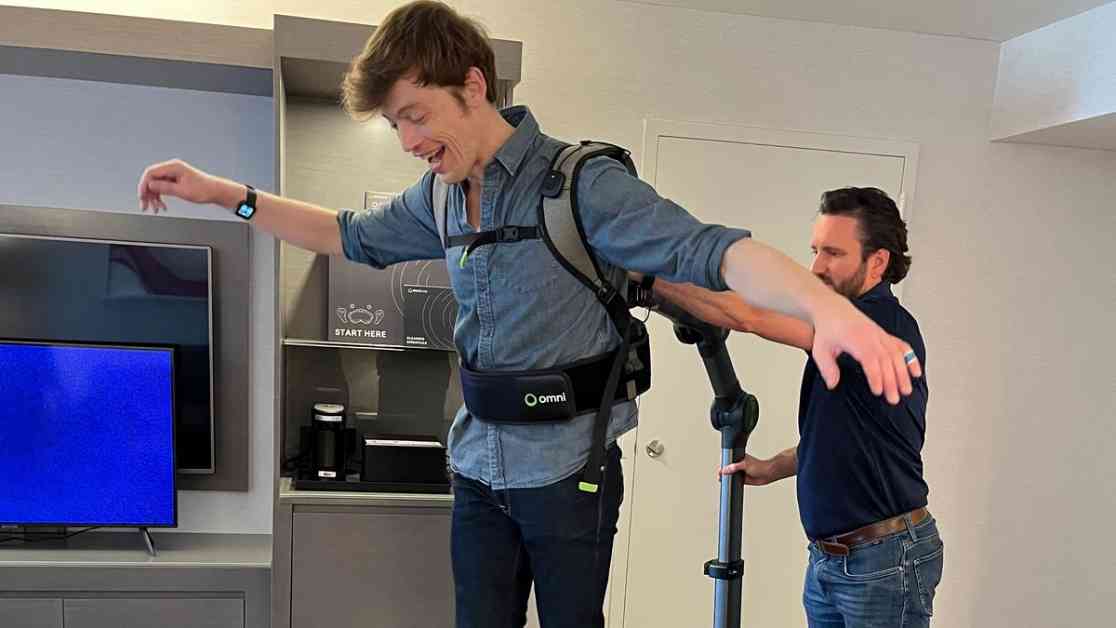I recently had the opportunity to experience the Virtuix Omni One, a full-body virtual reality gaming platform that promises to revolutionize the way we play games in VR. Priced at $2,595, the Omni One comes equipped with a 360-degree walking treadmill, an articulated support arm, a VR headset, and a vest and belt for added support. The goal of the Omni One is to allow users to walk, run, crouch, and jump in VR without the limitations of a traditional gaming setup in their living room.
As a long-time follower of VR technology, I was excited to try out the Omni One, especially since Virtuix has been in the game for over a decade. The company first gained attention with its successful Kickstarter campaign for the original Omni platform, and now they are back with an advanced version that is ready for home use. The Omni One is not just a treadmill; it is a full-fledged VR platform that offers a unique gaming experience unlike any other.
Unlike its competitors, such as the Meta Quest 3, the Omni One runs on its own platform and is designed to work best with games available on the Omni One store. While users can connect the Omni One to a PC to play Steam VR games, the real magic happens when you explore the games specifically tailored for the Omni One’s full-body movement capabilities. With over 50 games expected to be available at launch, including multiplayer titles that make full use of the Omni One’s features, Virtuix is aiming to create a compelling ecosystem for its proprietary VR game platform.
During my demo of the Omni One, I had the chance to play a multiplayer game with a Virtuix employee. Despite some initial struggles with the treadmill and harness, I found the overall experience to be immersive and engaging. The multiplayer match of a co-op zombie survival shooter went smoothly, and I was able to navigate the virtual world without feeling nauseous or risking injury. While there is a learning curve to using the Omni One, with practice, users can master the art of walking, running, and jumping in VR.
One of the key concerns I had during my time with the Omni One was the risk of injury. As a tall individual, I found that my legs were a bit too long for the device, and I had to be extra cautious to avoid potential accidents. The Omni One is designed to support users from 4’4″ to 6’4″ and up to 250 pounds, so smaller and younger users may find it more comfortable to use. Despite the initial challenges, once I got the hang of it, I was able to move around in VR with relative ease.
After spending an hour with the Omni One, I can say that I am intrigued by the possibilities it offers. The technology behind the Omni One is impressive, and the ease of assembly and transport make it a convenient option for VR enthusiasts. However, I am hesitant to invest in the Omni One until I see more software options and a thriving community of users. While the potential for immersive experiences is vast, the success of the Omni One will ultimately depend on the quality of the games available and the level of engagement from the VR community.
In conclusion, the Virtuix Omni One is a promising step towards a future where full-body VR experiences are more accessible to the general public. With its innovative design and unique features, the Omni One has the potential to revolutionize the way we play games in VR. While there are still some challenges to overcome, such as the risk of injury and the need for more compelling software, the Omni One represents a significant advancement in the world of virtual reality gaming. As technology continues to evolve, it will be exciting to see how Virtuix and other developers push the boundaries of what is possible in VR gaming.













